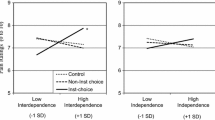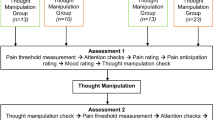Abstract
Accumulating evidence suggests that dispositional optimism might be a protective factor against experiencing pain. The current paper presents two studies investigating the association between dispositional optimism and experimental pain. Moreover, the influence of pain-specific expectations on this association is investigated. In Study 1, mediation of pain-specific expectations in the relation between dispositional optimism and pain was hypothesized. Expected and experienced pain ratings were obtained from 66 healthy participants undergoing a cold pressor tolerance task. In Study 2, the moderating effect of dispositional optimism on the association between induced pain expectations and pain reports was studied in 60 healthy participants undergoing a 1-min cold pressor task. Both studies controlled for individual differences in fear of pain. Significant associations between dispositional optimism and pain ratings were found in both studies, although the exact time point of these associations differed. Subscale analyses revealed that only the pessimism subscale contributed significantly to these findings. We found no evidence for hypothesized mediation and moderation effects. Alternative explanations for the optimism-pain association are discussed.

Similar content being viewed by others
Notes
For reasons of conciseness, all analyses will be reported for the 20 s during immersion rating. Analyses with the 5 s measure did not yield significantly different results and can be obtained from the corresponding author.
Bivariate correlation analyses were repeated in the group of participants who did not reach the 300 s tolerance limit and also for men and women separately, resulting in a comparable pattern of correlations. Additionally, no significant sex difference in optimism scores was found using an independent samples t test. These results indicate that maxing out the immersion time or an even sex distribution might not alter the results in a significant manner.
Identical to study 1 the rating at 20 s is reported as a measure of experienced pain during the immersion. Similar results were obtained when the 40 s ratings were analyzed.
Correlation analyses for the two conditions separately showed that the significance of the relations of optimism, fear of pain and pain-specific expectations with pain intensity ratings is restricted to the high pain expectations group. Coefficients for both groups separately can be obtained upon request.
References
Achat, H., Kawachi, I., Spiro, A., 3rd, DeMolles, D. A., & Sparrow, D. (2000). Optimism and depression as predictors of physical and mental health functioning: The Normative Aging Study. Annals of Behavioral Medicine, 22, 127–130.
Affleck, G., Tennen, H., Zautra, A., Urrows, S., Abeles, M., & Karoly, P. (2001). Women’s pursuit of personal goals in daily life with fibromyalgia: A value-expectancy analysis. Journal of Consulting and Clinical Psychology, 69, 587–596.
Armor, D. A., & Taylor, S. E. (1998). Situated optimism: Specific outcome expectancies and self-regulation. In M. P. Zanna (Ed.), Advances in experimental social psychology (Vol. 30, pp. 309–379). New York: Academic Press.
Arntz, A., & Claassens, L. (2004). The meaning of pain influences its experienced intensity. Pain, 109, 20–25.
Arntz, A., van Eck, M., & Heijmans, M. (1990). Predictions of dental pain: The fear of any expected evil, is worse than the evil itself. Behaviour Research and Therapy, 28, 29–41.
Asmundson, G. J., Bovell, C. V., Carleton, R. N., & McWilliams, L. A. (2008). The Fear of Pain Questionnaire-Short Form (FPQ-SF): Factorial validity and psychometric properties. Pain, 134, 51–58.
Bargiel-Matusiewicz, K., & Krzyszkowska, A. (2009). Dispositional optimism and coping with pain. European Journal of Medical Research, 14(Suppl 4), 271–274.
Baron, R. M., & Kenny, D. A. (1986). The moderator-mediator variable distinction in social psychological research: Conceptual, strategic, and statistical considerations. Journal of Personality and Social Psychology, 51, 1173–1182.
Benedetti, F., Pollo, A., Lopiano, L., Lanotte, M., Vighetti, S., & Rainero, I. (2003). Conscious expectation and unconscious conditioning in analgesic, motor, and hormonal placebo/nocebo responses. Journal of Neuroscience, 23, 4315–4323.
Brenes, G. A., Rapp, S. R., Rejeski, W. J., & Miller, M. E. (2002). Do optimism and pessimism predict physical functioning? Journal of Behavioral Medicine, 25, 219–231.
Carson, J. W., Keefe, F. J., Lynch, T. R., Carson, K. M., Goli, V., Fras, A. M., et al. (2005). Loving-kindness meditation for chronic low back pain: results from a pilot trial. [Randomized Controlled Trial]. Journal of Holistic Nursing: Official Journal of the American Holistic Nurses’ Association, 23, 287–304.
Chen, A. C., Dworkin, S. F., Haug, J., & Gehrig, J. (1989). Human pain responsivity in a tonic pain model: psychological determinants. Pain, 37, 143–160.
Colloca, L., Sigaudo, M., & Benedetti, F. (2008). The role of learning in nocebo and placebo effects. Pain, 136, 211–218.
Costello, N. L., Bragdon, E. E., Light, K. C., Sigurdsson, A., Bunting, S., Grewen, K., et al. (2002). Temporomandibular disorder and optimism: Relationships to ischemic pain sensitivity and interleukin-6. Pain, 100, 99–110.
Devine, D. P., & Spanos, N. P. (1990). Effectiveness of maximally different cognitive strategies and expectancy in attenuation of reported pain. Journal of Personality and Social Psychology, 58, 672–678.
Geers, A. L., Helfer, S. G., Kosbab, K., Weiland, P. E., & Landry, S. J. (2005). Reconsidering the role of personality in placebo effects: dispositional optimism, situational expectations, and the placebo response. Journal of Psychosomatic Research, 58, 121–127.
Geers, A. L., Kosbab, K., Helfer, S. G., Weiland, P. E., & Wellman, J. A. (2007). Further evidence for individual differences in placebo responding: an interactionist perspective. Journal of Psychosomatic Research, 62, 563–570.
Geers, A. L., Wellman, J. A., Fowler, S. L., Helfer, S. G., & France, C. R. (2010). Dispositional Optimism Predicts Placebo Analgesia. Journal of Pain.
Geers, A. L., Wellman, J. A., Helfer, S. G., Fowler, S. L., & France, C. R. (2008). Dispositional optimism and thoughts of well-being determine sensitivity to an experimental pain task. Annals of Behavioral Medicine, 36, 304–313.
Karoly, P., & Ruehlman, L. S. (2006). Psychological “resilience” and its correlates in chronic pain: findings from a national community sample. Pain, 123, 90–97.
Keltner, J. R., Furst, A., Fan, C., Redfern, R., Inglis, B., & Fields, H. L. (2006). Isolating the modulatory effect of expectation on pain transmission: A functional magnetic resonance imaging study. Journal of Neuroscience, 26, 4437–4443.
Klein, B., & Zajec, L. (2008). Imagining a rosy future: The psychology of optimism. In K. D. Markman, W. M. P. Klein, & J. A. Suhr (Eds.), Handbook of imagination and mental simulation. New York: Psychology press.
Leeuw, M., Goossens, M. E., Linton, S. J., Crombez, G., Boersma, K., & Vlaeyen, J. W. (2007). The fear-avoidance model of musculoskeletal pain: current state of scientific evidence. Journal of Behavioral Medicine, 30, 77–94.
Linton, S. J., & Shaw, W. S. (2011). Impact of psychological factors in the experience of pain. Physical Therapy, 91, 700–711.
Lorenz, J., Hauck, M., Paur, R. C., Nakamura, Y., Zimmermann, R., Bromm, B., et al. (2005). Cortical correlates of false expectations during pain intensity judgments–a possible manifestation of placebo/nocebo cognitions. Brain, Behavior, and Immunity, 19, 283–295.
Mahler, H. I. M., & Kulik, J. A. (2000). Optimism, pessimism and recovery from coronary bypass surgery: Prediction of affect, pain and functional status. Psychology, Health & Medicine, 5, 347–358.
Mangelli, L., Gribbin, N., Buchi, S., Allard, S., & Sensky, T. (2002). Psychological well-being in rheumatoid arthritis: Relationship to ‘disease’ variables and affective disturbance. Psychotherapy and Psychosomatics, 71, 112–116.
McCracken, L. M., Gross, R. T., Sorg, P. J., & Edmands, T. A. (1993). Prediction of pain in patients with chronic low back pain: Effects of inaccurate prediction and pain-related anxiety. Behaviour Research and Therapy, 31, 647–652.
Mirsky, J. B. (2007). Expectancy and the placebo effect: How cognitive processing utilizes the rACC to alter the perception of pain. Mind Matters: The Wesleyan Journal of Psychology, 2, 19–28.
Morton, D. L., Watson, A., El-Deredy, W., & Jones, A. K. (2009). Reproducibility of placebo analgesia: Effect of dispositional optimism. Pain, 146, 194–198.
Novy, D. M., Nelson, D. V., Hetzel, R. D., Squitieri, P., & Kennington, M. (1998). Coping with chronic pain: Sources of intrinsic and contextual variability. Journal of Behavioral Medicine, 21, 19–34.
Ong, A. D., Zautra, A. J., & Reid, M. C. (2010). Psychological resilience predicts decreases in pain catastrophizing through positive emotions. Psychology and Aging, 25, 516–523.
Powell, R., Johnston, M., Smith, W. C., King, P. M., Chambers, W. A., Krukowski, Z., et al. (2012). Psychological risk factors for chronic post-surgical pain after inguinal hernia repair surgery: A prospective cohort study. European Journal of Pain, 16, 600–610.
Ramirez-Maestre, C., Esteve, R., & Lopez, A. E. (2012a). The path to capacity: Resilience and spinal chronic pain. Spine, 37, E251–E258.
Ramirez-Maestre, C., Esteve, R., & Lopez, A. E. (2012b). The role of optimism and pessimism in chronic pain patients adjustment. The Spanish Journal of Psychology, 15, 286–294.
Rasmussen, H. N., Scheier, M. F., & Greenhouse, J. B. (2009). Optimism and physical health: A meta-analytic review. Annals of Behavioral Medicine, 37, 239–256.
Robinson-Whelen, S., Kim, C., MacCallum, R. C., & Kiecolt-Glaser, J. K. (1997). Distinguishing optimism from pessimism in older adults: Is it more important to be optimistic or not to be pessimistic? Journal of Personality and Social Psychology, 73, 1345–1353.
Roelofs, J., Peters, M. L., Patijn, J., Schouten, E. G., & Vlaeyen, J. W. (2004). Electronic diary assessment of pain-related fear, attention to pain, and pain intensity in chronic low back pain patients. Pain, 112, 335–342.
Scheier, M. F., & Carver, C. S. (1985). Optimism, coping, and health: Assessment and implications of generalized outcome expectancies. Health Psychology, 4, 219–247.
Scheier, M. F., & Carver, C. S. (1992). Effects of optimism on psychological and physical well-being: Theoretical overview and empirical update. Cognitive Therapy and Research, 16, 201–228.
Scheier, M. F., Carver, C. S., & Bridges, M. W. (1994). Distinguishing optimism from neuroticism (and trait anxiety, self-mastery, and self-esteem): A reevaluation of the Life Orientation Test. Journal of Personality and Social Psychology, 67, 1063–1078.
Segerstrom, S. C. (2005). Optimism and immunity: do positive thoughts always lead to positive effects? Brain, Behavior, and Immunity, 19, 195–200.
Sipila, K., Ylostalo, P. V., Ek, E., Zitting, P., & Knuuttila, M. L. (2006). Association between optimism and self-reported facial pain. Acta Odontologica Scandinavica, 64, 177–182.
Solberg Nes, L., & Segerstrom, S. C. (2006). Dispositional optimism and coping: A meta-analytic review. Personality and Social Psychology Review, 10, 235–251.
Sturgeon, J. A., & Zautra, A. J. (2010). Resilience: A new paradigm for adaptation to chronic pain. Current Pain and Headache Reports, 14, 105–112.
Vlaeyen, J. W., Hanssen, M., Goubert, L., Vervoort, T., Peters, M., van Breukelen, G., et al. (2009). Threat of pain influences social context effects on verbal pain report and facial expression. Behaviour Research and Therapy, 47, 774–782.
Vlaeyen, J. W., & Linton, S. J. (2000). Fear-avoidance and its consequences in chronic musculoskeletal pain: a state of the art. Pain, 85, 317–332.
Vlaeyen, J. W., & Linton, S. J. (2012). Fear-avoidance model of chronic musculoskeletal pain: 12 years on. Pain (in press).
Wiech, K., Ploner, M., & Tracey, I. (2008). Neurocognitive aspects of pain perception. Trends in Cognitive Sciences, 12, 306–313.
Wright, L. J., Zautra, A. J., & Going, S. (2008). Adaptation to early knee osteoarthritis: The role of risk, resilience, and disease severity on pain and physical functioning. Annals of Behavioral Medicine, 36, 70–80.
Acknowledgments
We thank Astrid Dello, Sandra Nijsten and Ina Schabram for their valuable input in these studies and for their assistance in the data collection. This study was supported by a grant from the Netherlands Foundation of Scientific Research.
Author information
Authors and Affiliations
Corresponding author
Rights and permissions
About this article
Cite this article
Hanssen, M.M., Vancleef, L.M.G., Vlaeyen, J.W.S. et al. More optimism, less pain! The influence of generalized and pain-specific expectations on experienced cold-pressor pain. J Behav Med 37, 47–58 (2014). https://doi.org/10.1007/s10865-012-9463-8
Received:
Accepted:
Published:
Issue Date:
DOI: https://doi.org/10.1007/s10865-012-9463-8




